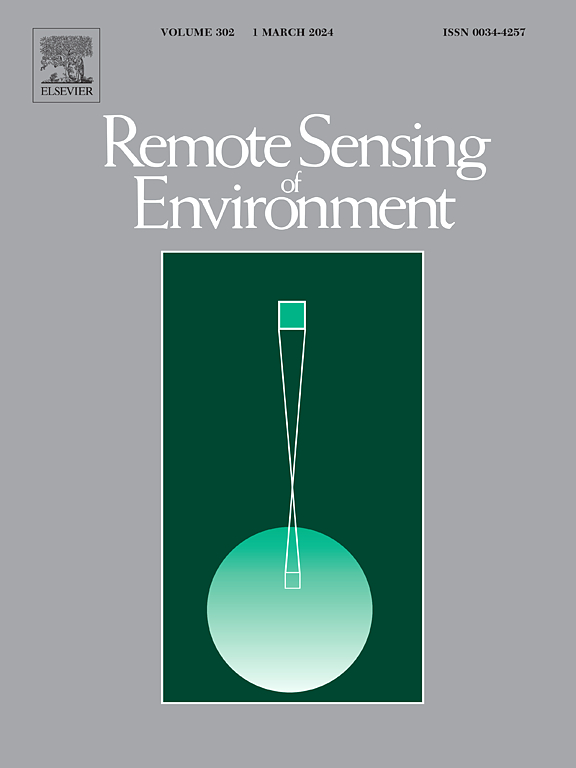利用光谱混合分析估算全球成像光谱中的土壤和植被覆盖
IF 11.1
1区 地球科学
Q1 ENVIRONMENTAL SCIENCES
引用次数: 0
摘要
地球表面矿物尘埃源调查(EMIT)是目前安装在国际空间站上的可见光到短波红外成像光谱仪。从光谱分解算法推导出的覆盖度分数提供了对各种生态系统功能的见解。在EMIT的情况下,它们将被多个全球地球系统模型用于约束与尘埃有关的辐射强迫的迹象。本研究旨在评估不同方法在估算分数覆盖度和量化相应不确定性方面的有效性,并作为一个模型来封装EMIT的真实误差预算。我们从不同旱地的光谱库中模拟地表反射率,生成数百万个候选光谱,这些光谱由非光合植被(NPV)、绿色植被(GV)和土壤的不同随机组分组成。模拟光谱是按原样使用的,但我们也测试了大气条件/表面反射率检索的影响,通过使用它们计算大气顶辐射,然后使用当前的EMIT表面反射率检索算法估计地表表观反射率。我们测试了几种方法来解混这些模拟光谱,使用多种策略来处理光谱亮度、类内光谱变异性和库选择。我们还采用了蒙特卡罗方法来稳定分数覆盖检索和量化不确定性。最佳光谱分解方法产生平均绝对误差<;净现值和土壤为0.10;GV为0.06,所有类别的不确定度≤±0.02。我们将这种创新方法命名为端元组合蒙特卡罗,E(MC)2,解混,并发现我们的分数覆盖检索对表面反射率数据中的大气残差不敏感。本文章由计算机程序翻译,如有差异,请以英文原文为准。
Soil and vegetation cover estimation for global imaging spectroscopy using spectral mixture analysis
The Earth surface Mineral dust source InvesTigation (EMIT) is a visible-to-shortwave infrared imaging spectrometer currently aboard the International Space Station. Derivations of fractional cover from spectral unmixing algorithms have provided insights into various ecosystem functions. In the case of EMIT, they will be used by multiple global Earth systems models to constrain the sign of dust-related radiative forcing. This study aims to evaluate the efficacy of different approaches for estimating fractional cover and quantifying the corresponding uncertainty, and serves as a model to encapsulate the true error budget for EMIT. We simulated surface reflectance from a spectral library compiled from various drylands to generate millions of candidate spectra made up of different random fractions of nonphotosynthetic vegetation (NPV), green vegetation (GV), and soil. Simulated spectra were used as-is but we also tested the impact of atmospheric conditions/surface reflectance retrieval by using them to calculate top-of-atmosphere radiance then using the current EMIT surface reflectance retrieval algorithm to estimate apparent surface reflectance. We tested approaches to unmixing these simulated spectra using multiple strategies for dealing with spectrum brightness, within-class spectral variability, and library selection. We also incorporated a Monte Carlo approach to stabilize fractional cover retrievals and quantify uncertainty. The best spectral unmixing approaches produced mean absolute error < 0.10 for NPV and soil and < 0.06 for GV with uncertainties 0.02 for all classes. We named this innovative approach EndMember Combination Monte Carlo, E(MC)2, unmixing and found that our fractional cover retrievals are insensitive to atmospheric residuals in the surface reflectance data.
求助全文
通过发布文献求助,成功后即可免费获取论文全文。
去求助
来源期刊

Remote Sensing of Environment
环境科学-成像科学与照相技术
CiteScore
25.10
自引率
8.90%
发文量
455
审稿时长
53 days
期刊介绍:
Remote Sensing of Environment (RSE) serves the Earth observation community by disseminating results on the theory, science, applications, and technology that contribute to advancing the field of remote sensing. With a thoroughly interdisciplinary approach, RSE encompasses terrestrial, oceanic, and atmospheric sensing.
The journal emphasizes biophysical and quantitative approaches to remote sensing at local to global scales, covering a diverse range of applications and techniques.
RSE serves as a vital platform for the exchange of knowledge and advancements in the dynamic field of remote sensing.
 求助内容:
求助内容: 应助结果提醒方式:
应助结果提醒方式:


